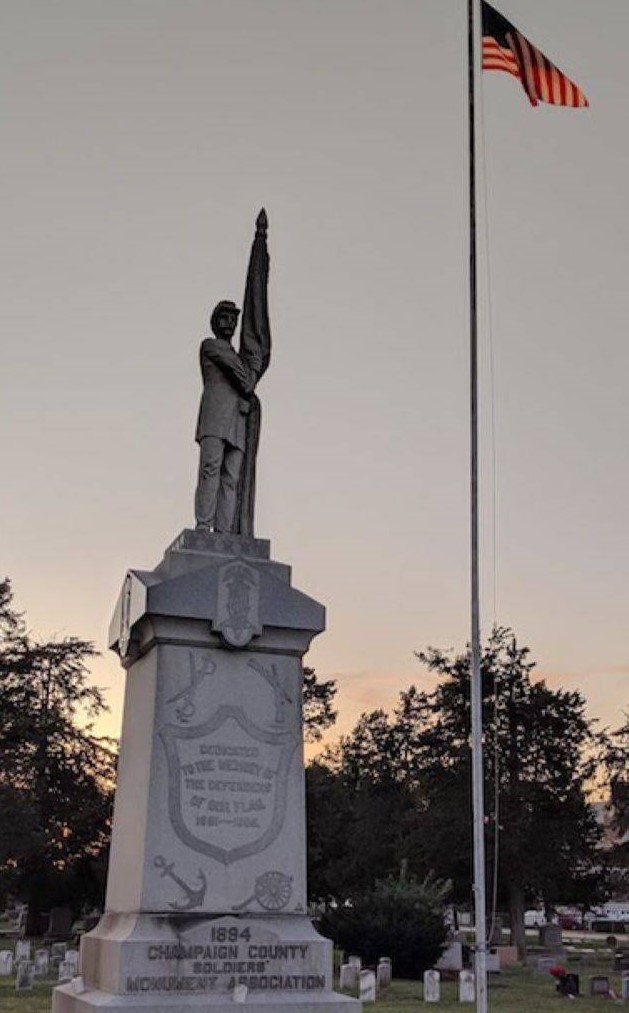African American Civil War Burials and Mt. Hope Cemetery
611 East Pennsylvania Avenue, Champaign, IL
Located west of Memorial Stadium at the University of Illinois at Urbana-Champaign, Mount Hope Cemetery (611 E. Pennsylvania Ave., Champaign, IL) was plotted and internment began in 1856. Sitting on the dividing line between the two cities, it’s the oldest operating cemetery in Champaign-Urbana. Throughout its 150 years, it has been the final resting place for many local African Americans and their families, including most of those who fought in the Civil War. The majority of these veterans were buried in what was the Grand Army of the Republic’s (G.A.R.) section, now known as the “old” veteran's section, found as you enter the cemetery. It is represented by the Civil War Memorial and a 32-pound canon built in 1851. However, many of the original markers no longer exist for many of these and other Civil War veterans, or they were moved to other locations in the cemetery.
African Americans veterans from various wars including World War I and II are also buried in this section.
Many local African Americans who fought in the Civil War are buried in Mount Hope Cemetery in Champaign-Urbana (611 E. Pennsylvania Ave.) as well as in other cemeteries around the county. Although many individual markers do not exist or have not been relocated, our understanding of which Civil War veterans buried at Mount Hope and other cemeteries are based on available records. The list of veterans below, though extensively researched, may not be complete.
Mt. Hope Cemetery, Urbana
Jordan Anderson, Pvt, 28th U.S. Volunteers (28th USCT)
James H. Bell, Pvt, Co D, 29th USCT
William. G. Blackburn, Pvt, Co I, 50th USCT, died 20 January 1893
Elijah Gibbs, Cpl, Co H, 55th MA Vols
George. W. Johnson, Pvt, Co K, 118th US Inf (118th USCT)
David Johnson, Wagoner, 29th USCT
John C. Louis (Lewis), Sgt, Co D, 28th USCT
Martin McDermot, Pvt, US gunboat Hastings
John R. Merrick, Pvt, Co I, 55th MA Vols
John Moss, Pvt, Co H, 55th MA Inf
Ruff Phillips, Pvt, Co C, 48th MO Vol, and Drummer, 7th IL Cav
James (Jess) E. Riley, Pvt, Co K, 29th USCT
Stephen Roey, Pvt, Co C, 1l0th USCT
Simon Ross, Pvt, Co K, 49th USCT and Co I, II the USCT
William Summerville, Pvt, Co G, 29th USCT
Larkin. H. Walden, Pvt, Co I, 55.th MA Vols
James Walker; Pvt, Co K, 118th USCT
William. P. Winn, Cpl, Co. D, 18th USCT
Stephen Winston, Co C, 1l0th USCT, died 4 May 1900
Homer GAR Cemetery, Homer IL
Samuel Persons, Sgt, 29th USCT, Co. F
Old Homer Cemetery, Homer, IL
C. Cone, 54th US Cav (54th USCT)
Mt. Hope Cemetery, Sidney, IL
Isaac Beard, Pvt, Co C, 13th USCT
Source:
From Salt Fork to Chickamaunga: Champaign County Soldiers in the Civil War, Chapter 22 “Black Soldiers in the Civil War,” by Robert H. Behrens [Urbana, IL: Urbana Free Library, 1988] pps. 371-381.
Decade:
1850-1859
Location(s):
- Champaign, Illinois
- Urbana, Illinois
Additional Champaign Trail Sites

